IPv4 vs IPv6. Key Differences.
Last updated on May 8th, 2023 in General
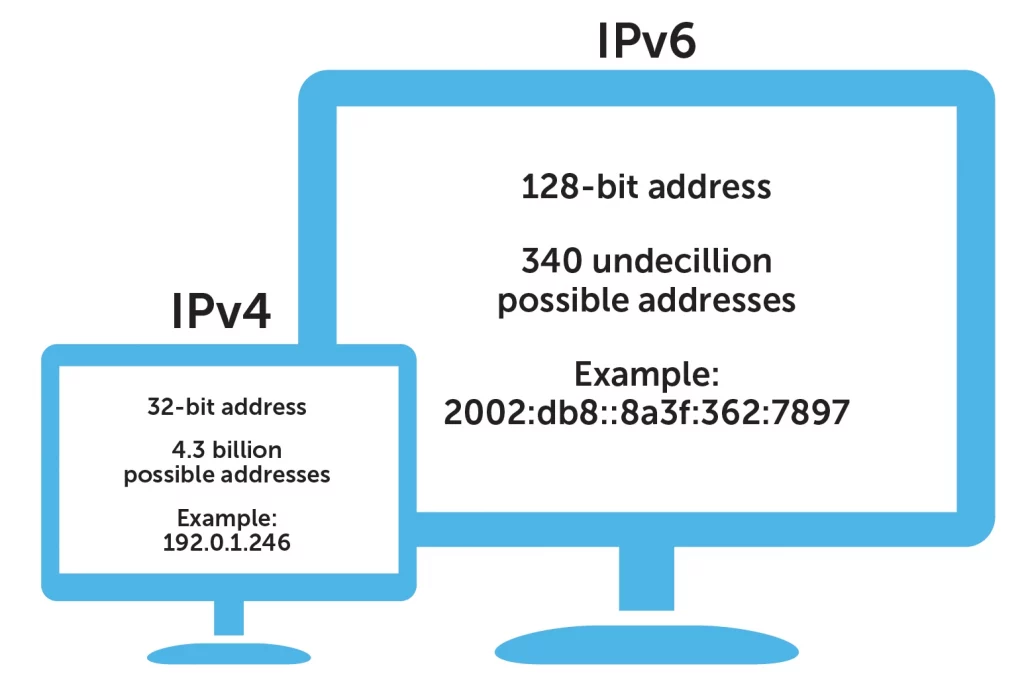
Are you familiar with IPv4 and IPv6 or at least IPv4 vs IPv6 controversy? These are two major versions of the Internet Protocol (IP) that we use to connect devices to the internet. While IPv4 has been around for decades, it is now facing limitations due to increasing demand for IP addresses.
This is where IPv6 comes in as a newer version that promises more available addresses and improved security features. In this blog post, we will explore the key differences between IPv4 vs IPv6, why the transition is taking so long, and how you can prepare your network for the switch! So let’s dive in and discover what makes these two protocols unique.
Table of contents
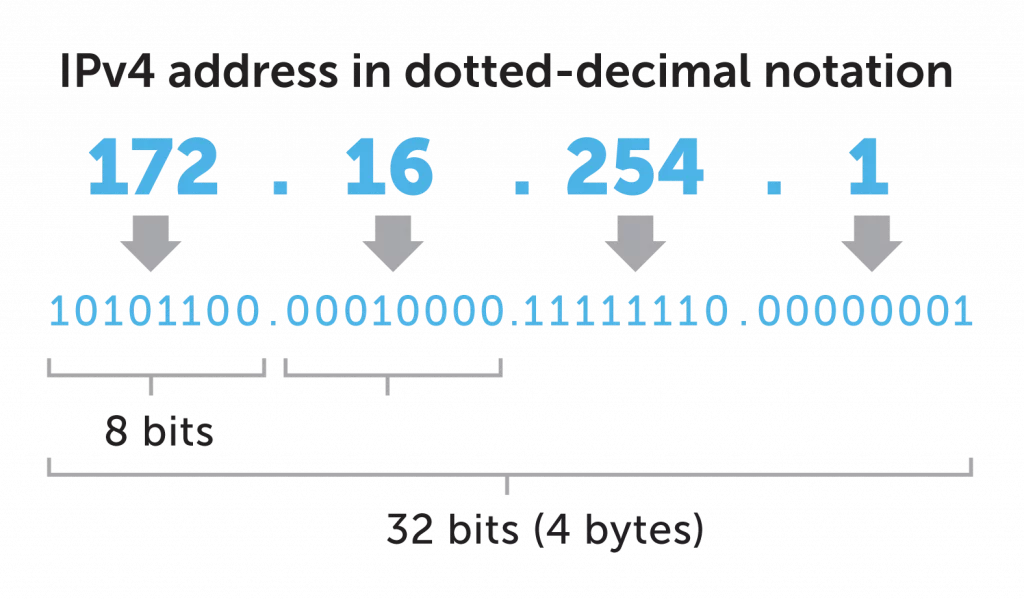 IPv4 is the fourth version of the Internet Protocol (IP) and was first introduced in 1983. This protocol works by assigning a unique IP address to each device connected to the internet. It allows for communication between them. An IPv4 address consists of 32 bits divided into four sections separated by dots. Each section ranges from 0 to 255.
IPv4 is the fourth version of the Internet Protocol (IP) and was first introduced in 1983. This protocol works by assigning a unique IP address to each device connected to the internet. It allows for communication between them. An IPv4 address consists of 32 bits divided into four sections separated by dots. Each section ranges from 0 to 255.
One limitation of IPv4 is its limited number of available addresses, which has become a pressing issue due to the growing number of devices connecting to the internet worldwide. With over 7 billion people on Earth and an average person owning multiple devices that require IP addresses such as smartphones, laptops, smart TVs and more – we are quickly running out of available IPv4 addresses.
To combat this problem, network administrators have implemented various workarounds. Some like that are Network Address Translation (NAT) but these solutions only delay or exacerbate future issues. In order to solve this problem permanently, a new protocol known as IPv6 was developed with improved features that overcome these limitations. This is mainly where the IPv4 vs IPv6 debate on usability started.
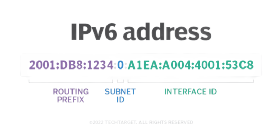 IPv6 is the latest version of the Internet Protocol that has been designed to replace its predecessor, IPv4. It was introduced in 1998 by the Internet Engineering Task Force (IETF). And it was posed as a solution to address some of the limitations and shortcomings of IPv4.
IPv6 is the latest version of the Internet Protocol that has been designed to replace its predecessor, IPv4. It was introduced in 1998 by the Internet Engineering Task Force (IETF). And it was posed as a solution to address some of the limitations and shortcomings of IPv4.
One key difference between IPv6 and IPv4 is the size of their respective IP addresses. While an IPV4 address uses a 32-bit format, which allows for approximately four billion unique addresses, an IPV6 address uses a 128-bit format that can accommodate around 340 undecillion unique IP addresses.
Another significant difference is in how both protocols handle packet fragmentation. In IPv4, packets are often fragmented along their path to ensure they fit within smaller network sizes. However, this process can lead to delays or lost data if not handled correctly. Meanwhile, with IPv6’s larger packet size capacity and built-in MTU discovery feature, these issues become less frequent.
While it may take some time for organizations and internet users alike to fully adopt IPv6 due to its differences from previous versions like IPV4., it offers much-needed improvements that help ensure more secure connectivity across today’s networks. There is always more to learn about what is IPv6 but today we focus on the differences.
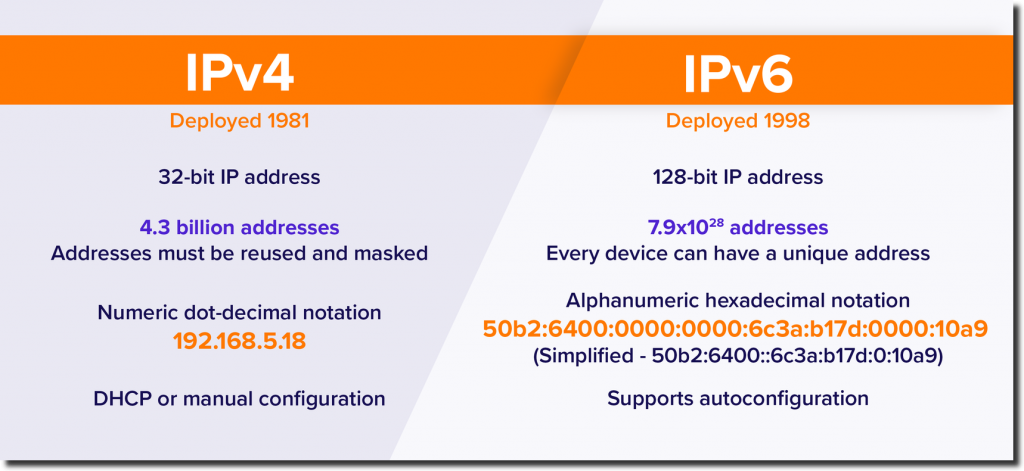 IPv4 and IPv6 are two different versions of the Internet Protocol (IP) that are used to identify devices on a network. The primary difference between these two protocols is the number of IP addresses they can support.
IPv4 and IPv6 are two different versions of the Internet Protocol (IP) that are used to identify devices on a network. The primary difference between these two protocols is the number of IP addresses they can support.
IPv4 uses 32-bit addresses, which limits it to about 4 billion unique IP addresses. This limitation has led to IPv4 address exhaustion, where there are no more available IP addresses for new devices.
On the other hand, IPv6 uses 128-bit addresses which offers an almost unlimited number of unique IP addresses. This means that every device in the world could have its own unique IP address without running out anytime soon.
Another key difference between these protocols is how they handle packet fragmentation. In IPv4 networks, routers must fragment packets when their size exceeds maximum transmission unit (MTU). However, this process may lead to slower performance and increased latency due to additional processing overheads.
In contrast, IPv6 eliminates packet fragmentation by increasing its default MTU size from 1500 bytes in IPv4 to up to 64000 bytes in some cases. This leads to faster communication speeds and reduced network congestion. This is a point where IPv4 vs IPv6 debate favors the later one.
While both protocols provide basic connectivity functions for networking devices over the internet or local area networks (LAN), it’s crucial for organizations and individuals alike to understand these differences before making any decision about transitioning from one protocol version to another.
The transition from IPv4 to IPv6 has been a long time coming, but why is it taking so long? One reason is that the two protocols are not compatible, meaning that all hardware and software must be updated to support IPv6. This can be costly for companies who have invested heavily in their current infrastructure.
Another factor contributing to the slow adoption of IPv6 is simply human resistance to change. Many IT professionals are comfortable with using IPv4 and see no need to switch unless they encounter problems with address depletion.
Additionally, there may be a lack of understanding about the benefits that come with transitioning to IPv6. While addressing limitations are an obvious benefit, other advantages include improved security features and enhanced network performance.
Some governments have been slow to mandate the switch over from IPV4. Without a strong push or incentive for companies and organizations worldwide, many will likely continue using IPV4 until it becomes absolutely necessary to upgrade.
While progress towards adopting IPV6 has been slow thus far, we can expect more widespread adoption as demand for internet-connected devices continues to grow.
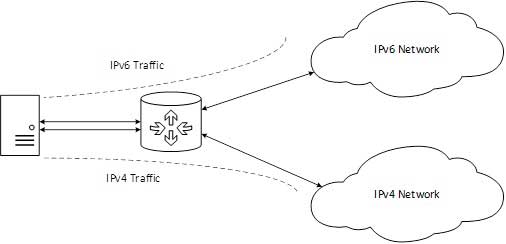
As the world continues to advance technologically, it is important for businesses and individuals to prepare their networks for the transition from IPv4 to IPv6. Here are some steps you can take to ensure a smooth transition.
Firstly, assess your current network infrastructure and determine which devices are compatible with IPv6. It’s important to know what changes need to be made before making any updates.
Next, create an inventory of all IP addresses currently in use on your network. This will help you better understand how many addresses you will need when transitioning to IPv6.
Once you have identified all devices that are not compatible with IPv6, consider upgrading or replacing them if necessary. This may seem daunting at first but will ultimately make the transition smoother and less prone to errors.
It’s also crucial that IT staff receive proper training on how to configure and manage an IPv6 network. With new protocols come new procedures so it’s essential everyone involved understands its operation correctly.
Implement a plan for gradually phasing out IPv4 devices as opposed to abruptly switching over completely. This helps avoid system downtime issues during the transitional period.
By following these steps towards transitioning smoothly into IPV6 you can ensure your business or personal computer stays up-to-date with today’s technological advancements while avoiding possible mishaps along the way!
IPv4 and IPv6 are both important protocols that allow devices to communicate with each other over the internet. However, there are significant differences between them that cannot be ignored.
IPv6 offers a larger address space, improved security features, and better support for mobile devices. Despite these advantages, many organizations have been slow to make the transition from IPv4 to IPv6 due to various reasons such as cost implications or lack of technical expertise.
As more and more devices continue to connect to the internet every day, it becomes increasingly important for businesses and individuals alike to prepare for the inevitable transition from IPv4 to IPv6.
By understanding the key differences between these two protocols and taking steps towards upgrading your network infrastructure accordingly you can ensure that your business remains competitive in an ever-evolving digital landscape.